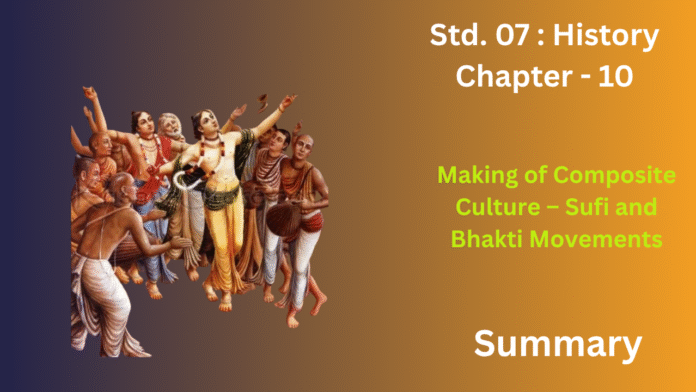The chapter probably outlines the fundamental doctrines of both movements. Sufism, an Islamic mystical tradition, emphasized profound love and devotion towards the Divine, the necessity of a spiritual mentor (Pir), and practices such as music and devotional singing (Qawwali) to attain spiritual union. It likely highlights the Sufis’ stress on empathy, tolerance, and selfless service, which resonated with individuals from diverse religious backgrounds. Key Sufi saints and their contributions in disseminating these ideals across various regions would likely be discussed.
Similarly, the Bhakti movement, a Hindu devotional tradition, stressed intense personal affection and dedication to a specific deity. It championed a direct connection with God, irrespective of social stratification or gender. The chapter likely examines the teachings of prominent Bhakti saints throughout India, emphasizing their utilization of regional languages for their devotional poetry and songs, which rendered their message accessible to the common populace. It would probably underscore their rejection of rigid ceremonial practices and social hierarchies.
The central argument of the chapter would likely be the manner in which interactions between Sufi and Bhakti saints and their adherents fostered a fusion of religious concepts and practices. They frequently employed analogous ideas such as the singularity of God, the significance of love and devotion, and the dismissal of superficial rituals. This cross-fertilization nurtured mutual respect and understanding between Hindus and Muslims at the grassroots level, significantly contributing to the evolution of a shared composite culture in India. The chapter would likely conclude by emphasizing the enduring influence of these movements on Indian society and their contribution to its rich and multifaceted cultural legacy.
Time To Learn
I. Fill in the blanks:
1. The Sufi saints were organised into various orders or ___________ .
Ans: Silsilahs.
2. The Chishti order was established in India by ________________ .
Ans: Moin-ud-din Chishti.
3. Kabir’s couplets were known as _____________ .
Ans: Kabirpanthis.
4. Guru Nanak was bom in ________________ .
Ans: 1469 AD.
5. Chaitanya Mahaprabhu believed in ___________ as the most important means of expressing ________________ .
Ans: kirtan , devotion to God.
6. Meerabai worshipped ______________ .
Ans: Krishna.
7. _______________ preached the worship of Rama.
Ans: Ramanand
8. Sant Jnaneshwar wrote a commentary on the Gita, known as ____________________ .
Ans: Dhyaneshwari.
9. Sant Tukaram composed devotional songs in praise of _______________ .
Ans: Vithoba (Lord Krishna).
10. The Bhakti and Sufi movements brought about an _________________ among the Hindus and Muslims.
Ans: understanding
II. Match the contents of Column A with those of Column B:


Answer:

III. State whether the following statements are Ture or False:
- Early Sufis came from Central Asia.
False.
- Sufis believed in caste distinctions.
False.
- Meerabai was an ardent devotee of Lord Krishna.
True.
- Kabir was a weaver by profession.
True.
- The Marathi devotional songs are known as kirtans.
False.
- Sant Tukaram was a contemporary of Shivaji.
True.
IV. Answer the following questions:
Question 1.
Who were the Sufis? What were their teachings? Name some famous Sufi saints.
Ans:
Sufis were Muslim mystics emphasizing inner love and devotion to God over strict rituals. They sought direct spiritual experience through practices like music and the guidance of a Pir. Their teachings promoted simplicity, tolerance, and universal love. Famous Sufi saints include Moinuddin Chishti, Baba Farid, Nizamuddin Auliya, and Amir Khusrau.
Question 2.
What do you understand by Bhakti? What were the teachings of the Bhakti reformers?
Ans:
Bhakti signifies intense, personal devotion to a specific deity, advocating a direct, loving connection with God, bypassing complex rituals and intermediaries. It emphasized love and surrender as the primary path to salvation.
Bhakti reformers taught the oneness of God, the paramountcy of love and devotion, and the rejection of rigid ritualism and caste hierarchies, promoting equality. They used vernacular languages to spread their message, highlighting the importance of a Guru and good moral conduct, portraying God as personal and accessible to all.
Question 3.
Who was Kabir? What were his teachings?
Ans:
A notable poet-saint from 15th-century India, Kabir, passionately promoted the concept of one Supreme Being, while offering sharp critiques of the insincerity of religious customs and the injustices of the caste system. 1 He emphasized love and deep spiritual commitment as the pathway to ultimate freedom, ardently advocating for harmony between Hindu and Muslim populations through his widely understandable and influential two-line verses in the prevalent Hindi vernacular.
Question 4.
How were the Bhakti and Sufi movements similar?
Ans:
Both the Bhakti and Sufi movements emphasized personal devotion to God, rejected rigid rituals, valued spiritual guides, used local languages, promoted equality and universalism, utilized music and poetry, focused on inner experience, and stressed compassion and service. These similarities fostered understanding and contributed to a composite culture in India.
Question 5.
Who was the founder of the Sikh religion? What are his main teachings?
Ans:
Guru Nanak, born in the Punjab region, was the revered founder of the Sikh religion. His central tenet was the belief in Ik Onkar, the concept of one, formless, and omnipresent God who is the sole creator. A cornerstone of his teachings was the absolute equality of all individuals, irrespective of their caste, creed, gender, or social standing, leading to his strong condemnation of the prevalent caste system.
Guru Nanak also emphasized the significance of leading an honest life through diligent and ethical labor (Kirat Karni), constantly remembering God’s name through meditation and devotion (Naam Japna), and engaging in selfless service to humanity without any expectation of reward (Sewa). Furthermore, he advocated for the principle of sharing one’s resources with those in need (Vand Chakna) and living a life grounded in truth. He rejected empty rituals, idol worship, and superstitious beliefs, focusing instead on inner spiritual devotion and championed respect for women. His teachings also promoted harmony and tolerance among different religious traditions.
Additional Questions
(Making of Composite Culture – Sufi and Bhakti Movements)
A. Fill in the blanks:
1. As the spirit of _________ and ____________ developed between the Hindus and the Muslims, two liberal religious ________ movements took shape in the Medieval Period. They were the _______ and _________ movements.
Ans: tolerance and understanding , reform , sufi and Bhakti
2. The Sufis came to India with the _________in the _______ century CE. Over the years, they absorbed __________ and _________ influences and were greatly respected by the Muslims as well as the _________ .
Ans: Turks , 12th , Buddhist and Hindu , Hindu.
3. The Bhakti Movement began in _______ India in the _____ century ce and became a popular movement before the arrival of the _______ .
Ans: South , 7th , Turks.
3. There were _____ Sikh gurus.
Ans: 10
4. The holy book of the Sikhs is known as the _____________________ .
Ans: Shri Guru Granth Sahibji.
5. The Sikhs worship in a ______________ which means door of the __________ .
Ans: Gurdwara , guru.
B. Match the following

Answer:

C. Choose the correct answer:
- 1. The Sufis were a group of Hindu/Buddhist/Muslim mystics.
Ans.
The Sufis were a group of Muslim mystics.
- The word ‘bhakti’ means fear of God/following rituals/ devotion to God.
Ans.
The word ‘bhakti’ means devotion to God.
- The Bhakti saints drew their inspiration from the Bhagwad Gita and the Vedas/Puranas/Upanishads.
Ans.
The Bhakti saints drew their inspiration from the Bhagwad Gita and the Upanishads.
- Guru Nanak/Guru Tegh Bahadur/Guru Gobind Singh was the founder of the Sikh religion.
Ans.
Guru Nanak was the founder of the Sikh religion.
- The word ‘Sikh’ is derived from a word which means teacher/disciple/warrior.
Ans.
The word Sikh’ is derived from a word which means disciple.
D. State whether the following are true or false:
- The organization of the Sufis was known as the sangha.
False.
Correct: The organization of the Sufis was known as the silsilas.
- Bhakti saints believed in monotheism.
True.
- Ramananda taught his message through dohas.
False.
Correct: Kabir taught his message through dohas.
- Chaitanya Mahaprabhu was a believer in the importance of following rituals.
False.
Correct: Chaitanya Mahaprabhu was a believer in the existence of God.
- Guru Tegh Bahadur was executed by Aurangzeb.
True.
E. Answer the following questions in one or two words/ sentences:
1. Who were the Sufis?
Ans.
Sufis were Muslim mystics who sought a direct, loving experience of God through inner purification and devotion, often guided by a Pir and using practices like music. They emphasized love, tolerance, and spiritual unity.
2. What are silsilas?
Ans.
Silsilas were the monsastic organizations of the Buddhist sangha and the Sufis.
3. Name the two popular Sufi orders in India.
Ans.
Chishti and the Suhrawardi orders, became popular in India.
4. What is the importance of qawwali in Sufism?
Ans.
One could come closer to God through devotional music qawwali.
5. Mention any one positive effect of the Bhakti Movement on Hindu-Muslim unity.
Ans.
One significant positive effect of the Bhakti Movement on Hindu-Muslim unity was the promotion of the idea that God is one, even if called by different names. Saints like Kabir explicitly emphasized the underlying unity of Allah and Ram, urging people to look beyond religious labels and find common ground in their devotion to a single divine reality. This resonated with both Hindu and Muslim communities, fostering an environment of greater understanding and reducing religious antagonism at the popular level.
6. What are dohas?
Ans.
Dohas were the simple, beautiful Hindi verses (poems) through which Kabir spread his message.
7. How did Meera Bai spread the message of Bhakti among the people.
Ans.
Meera Bai spread the message of devotion and love for’ od through devotional songs called Meera’s bhajans.
8. Name the five sacred symbols of Sikhism.
Ans.
The five sacred symbols of Sikhism are:
- Kesh,
- Kanga,
- Kaccha,
- Kirpan,
- Kara
9.Who transformed the Sikhs into a martial race?
Ans.
The tenth Sikh Guru, Guru Gobind Singh, is credited with transforming the Sikh community into a martial fraternity through the establishment of the Khalsa in 1699. This pivotal event involved an initiation ceremony and the mandatory adoption of the Five Ks, which instilled a sense of discipline and preparedness for defense, thereby forging a robust martial identity within the Sikh Panth.
10. How did the Sufi and Bhakti movements lead to the development of local languages?
Ans.
The Sufi and Bhakti movements fostered the development of local languages by preaching and composing in vernaculars, making their teachings accessible to the masses. This elevated the status of these languages and spurred literary growth as devotional poetry and songs enriched regional tongues. By lending religious legitimacy to local languages, they indirectly encouraged their standardization and further development.
F. Answer the following questions briefly:
Question 1.
What are the important teachings of the Sufi saints? Explain the impact of Sufism on the people and their rulers?
Ans:
Core Doctrines of Sufi Saints: Sufi mystics underscored the singularity of the Divine, prioritizing love and profound devotion as the principal spiritual path, emphasizing internal purification, the necessity of a spiritual mentor, simplicity in lifestyle, tolerance and universal compassion, the significance of music and poetic expression, and the primacy of direct spiritual experience over external religious formalities.
Influence on the Populace: Sufism cultivated religious understanding and concord, championed social egalitarianism, rendered religious concepts more comprehensible through local dialects, provided ethical and spiritual enrichment, functioned as hubs for education and philanthropy, and significantly contributed to the evolution of regional literature and musical traditions.
Influence on Rulers: The impact of Sufism sometimes led to more inclusive religious governmental approaches, provided rulers with enhanced legitimacy and public approval, offered counselors and intermediaries, and spurred the support of artistic and architectural endeavors. Nevertheless, the dynamic between Sufis and rulers was not invariably harmonious.
Question 2.
Explain the origin of the Bhakti Movement in India. Why did the teaching of the Bhakti saints appeal to the people?
Ans:
The Bhakti Movement originated in South India (7th-12th centuries) with the Alvar and Nayanar saints. It spread due to the accessibility of local languages, the emphasis on a personal connection with God, its message of social equality and rejection of rigid rituals, the emotional intensity of its expressions, and the hope and solace it offered to the common people.
Question 3.
Mention the chief teachings of the Bhakti saints.
Ans:
Bhakti saints mainly taught loving devotion to God, the oneness of the divine, rejection of rituals, social equality, vernacular language use, the need for a Guru, and achieving salvation through love.
Question 4.
Mention the important teachings of Sant Kabir.
Ans:
Kabir taught the oneness of God, criticized religious rituals and hypocrisy, and rejected the caste system, advocating for equality. He emphasized love and devotion as the path to God, prioritizing inner experience and promoting Hindu-Muslim unity through his simple vernacular poetry.
Question 5.
What are the main teachings of Guru Nanak? Why is the holy book of the Sikhs known as the Guru Granth Sahib?
Ans:
Guru Nanak’s core teachings encompass faith in a single, indivisible divine being, the intrinsic equal worth of all individuals, earning a livelihood through ethical work, spiritual contemplation and remembrance, unconditional service to humanity, the practice of distributing one’s possessions, living with unwavering honesty, the rejection of superstitious beliefs and empty customs, high regard for the dignity of women, and peaceful understanding among diverse religious groups.
The sacred scripture of the Sikh faith is called the Guru Granth Sahib because the final human Guru, Guru Gobind Singh, established that the holy text itself would be the everlasting Guru for all Sikhs. It comprises the divine hymns and teachings (Gurbani) of the Sikh Gurus and is venerated as the living representation of their spiritual wisdom and divine guidance, serving as the ultimate spiritual authority for the Sikh community.
Question 6.
What effect did the Bhakti and Sufi movements have on Indian society?
Ans:
The Bhakti and Sufi movements fostered personalized religion, promoted monotheistic ideas and religious tolerance, and challenged orthodoxies. Socially, they advocated for equality, empowered women, spurred social reform, and built communities. Culturally and linguistically, they developed vernacular languages, enriched literature and music, and created syncretic traditions, leaving a lasting impact on Indian society by promoting inclusivity and understanding.
G Picture study:
This is the picture of a monument associated with the founder of a religious reform movement in India.

Question 1.
Name the reformer and the movement he started in India.
Ans:
Religious reformer was Moinuddin Chishti. He started Sufi- Movements
Question 2.
Identify the monument.
Ans:
Dargah of Moinuddin Chisti.
Question 3.
Why is this monument famous?
Ans:
Here are the teachings you listed, explained in a unique way:
- All human beings are equal and God is only one. This principle, known as “Ik Onkar” (God is One), emphasizes a single, universal creator who is accessible to everyone, regardless of caste, gender, or background. It promotes a society where all people are treated with respect and dignity.
- All religions must be respected. This teaching highlights the importance of interfaith harmony. Guru Nanak taught that while paths may differ, they all lead to the same God. This message of tolerance and understanding is a cornerstone of the Sikh faith.
- Fasts and other rituals are not necessary. Guru Nanak rejected empty rituals and superstitions. He taught that true devotion comes from a pure heart and ethical living, not from meaningless traditions or practices. The focus is on inner spirituality rather than outward show.
- There is no need to convert to another religion. This tenet reinforces the idea that true spirituality comes from within. It teaches that one can achieve a connection with God without abandoning their own faith or identity. It’s about personal piety and living an honest life.
Question 4.
Mention any four important religious principles of that movement, which are common to the principles of the Bhakti Movement.
Ans:
(a) There is only one God.
(b) Everyone is equal in the eyes of God.
(c) God can be reached through love and devotion and total surrender to His will and not through rites, rituals and idol worship.
(d) Eveyone should lead a pure life.
Question 5.
Name any two religious reformers of the Bhakti Movement.
Ans:
Ramananda, Guru Nanak Dev ji.


